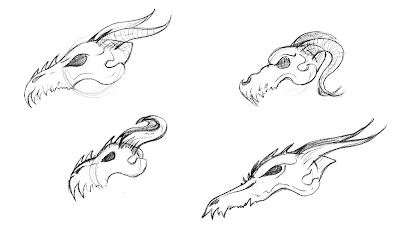Part of our course for this semester requires us to take a character through a full development process, from 2D concept art, turnaround and model sheet as well as a storyboard and animatic before we take the character into 3D and create a model that can be rigged and posed. I had originally planned to use the character I'm going to use for my final Project but since she is going to be low poly and not have a lot of detail, this assignment seemed like a good chance to try something different.
I went through several different sketches of what my character would wear before I settled on this.
I liked the basic shapes of this design and especially the tattoos. I took to Photoshop to add some colour and see what combinations I liked best.
After I found the colours I liked, I noticed that there were some issues with with the body shapes not matching between both pencil sketches for front and back so I tidied everything up a little in Photoshop and added the colour again.
My plan now is to use a character I've had in the back of my mind for a few years... more like 6 years. The Dragon Walker. She's a fantasy character with strong links to dragons and magic and has a tribal feel to her. So I started out with my inspiration board.
I love the style of Atlantis: The Lost Empire, Moana and Fable: The Journey artwork. So I pulled all of these references and ideas together to help me design my character.
I liked the basic shapes of this design and especially the tattoos. I took to Photoshop to add some colour and see what combinations I liked best.
After I found the colours I liked, I noticed that there were some issues with with the body shapes not matching between both pencil sketches for front and back so I tidied everything up a little in Photoshop and added the colour again.
In hindsight, I feel like I need to push the shapes more but I'll come back to that later. I then started to play about with different faces, skull shapes, and thumbnail some poses of what this character might do.











Comments
Post a Comment